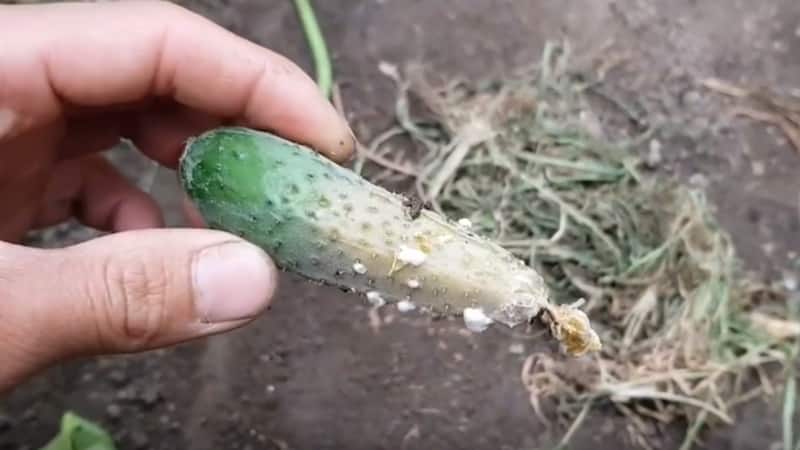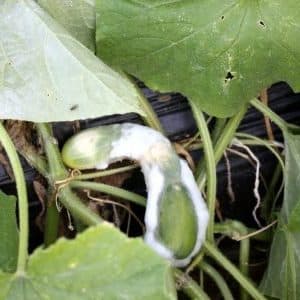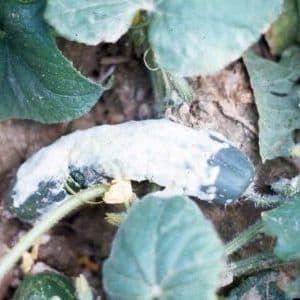How to cure cucumbers in a greenhouse from white rot
White rot is a dangerous disease that affects many crops and leads to complete or partial loss of crops. Getting rid of fungus on cucumbers is not so easy. There are many methods, but in order to choose the right one, you need to understand the cause of the disease and approach the problem in a comprehensive manner.
This article is devoted to the question of how to save cucumbers from white rot.
Why do cucumbers begin to rot in the greenhouse?
For the development of white rot, as a rule, two factors are enough: high humidity and low air temperature. However, other reasons can provoke the occurrence and development of the disease.
The main reasons for the appearance and spread of rot
Rot on cucumbers grown in open ground is caused by bad weather conditions: low air temperature, heavy and prolonged rainfall, lack of sun.
In greenhouse conditions, the fungus appears due to:
- poor ventilation or its complete absence;
- temperature changes day and night;
- condensation accumulations;
- glaze cold water;
- planting undisinfected seeds.
Also, the appearance and spread of rot can be caused by violation of the timing and rules of pruning, excessive planting density, or the use of dirty and possibly contaminated knives or pruners.

Pathogens
The causative agent of the disease is the marsupial fungus Sclerotinia sclerotiorum, a parasite that can develop on the plant body or in the environment.Fungal spores penetrate the plant tissue, germinate and form mycelium - a characteristic white coating resembling cotton wool.
Sclerotinia actively grows and forms fruiting bodies filled with new spores, which spread throughout the area or greenhouse and can affect the entire plantation.
Types of rot
The fungus can develop not only on fruits - it depends on the type of rot. So, the following varieties are distinguished:
- White - the result of the vital activity of a fungal parasitic organism. Affects any part of the plant.

- Root affects the root system. It is observed both on newly emerged seedlings and on mature plants.
- Gray most often develops on leaves, but can also affect fruits. The pathogen is resistant to environmental changes and remains viable on plant debris.
- Vershinnaya - a disease caused by a type of apical parasitic fungus. As a rule, it occurs as a result of a violation of the irrigation regime, a lack of calcium or an excess of nitrogen.
Any type of rot leads to damage to the bush and crop, so it is important to promptly identify the causes and begin to fight the disease.
White rot (sclerotinia): what is it?
White rot, or sclerotinia, is an infectious fungal disease, the external manifestation of which depends on the life cycle of the fungus.
Thus, at the sclerotial stage, the fungus develops on the surface or inside the plant in late summer - early autumn. It forms sclerotia - bodies that, at rest, endure the winter in the soil or plant debris.
When high humidity sets in and the air temperature rises to +16°C, sclerotia germinate and create fruiting bodies - thin stems with cups at the ends, 5-15 mm in diameter.They contain many ascospores that fall on damaged plants through the air. This is how the development of a fungal infection begins.
Symptoms
White rot has a number of symptoms that make it difficult to confuse it with other diseases:
- the appearance of a large number of wet spots on different parts of the plant;
- wateriness, sweetness of the affected areas;
- the formation of a white flocculent plaque on the foci of infection;
- wilting and death of leaves and shoot tips;
- development of black sclerotia on the affected parts, visible on the cut.
The manifestation of external signs depends on the stage of development of the disease.
Distribution routes
The primary source of infection is soil and plant debris in which sclerotia overwinter. In a plot or greenhouse, spores spread through the air, through insects and the gardener’s hands.
Danger
Sclerotinia is an insidious disease. Its main danger is:
- the ability to affect both young seedlings and fruit-bearing bushes, which leads to a drop in yield;
- long life of the fungus in the soil and on the remaining parts of the diseased plant;
- the likelihood of fungus being introduced when updating the soil or watering;
- damage to all parts of the plant.
In addition, the fungus can affect not only cucumbers, but also any other crop: its spores spread quickly, which entails disease of all plants, especially in a greenhouse.
Treatment methods for cucumbers
How to deal with the disease? Treatment of white rot on cucumbers in a greenhouse is carried out using special chemicals or folk remedies. This depends on the stage of development of the disease and the extent of its spread.
Unfortunately, in extreme cases, when the disease has reached its peak of development, radical measures are required - the complete destruction of the infected plant.
With the help of agrochemistry
The use of fungicides is an extreme measure that requires caution and compliance with personal safety rules. Treatment should be carried out in the morning or evening. The optimal air temperature for this is +20...+25°C during the day and +18...+22°C at night.
Spray the plants from bottom to top at a distance of 15 cm. Fungicides should not be used during fruiting and 20 days before it begins.
| Drug name | Quantity per 10 liters of water | Treatment |
| "HOM" | 40 g | Twice with an interval of 10-14 days |
| "Abiga Peak" | 50 ml | Spray the bushes three times a week apart |
| "Ordan" | 25 g | Double spraying with an interval of 10-14 days |
| "Oxyhom" | 30 g | Depending on the degree of damage, treatment is carried out 1-3 times with an interval of two weeks. |
| "Acrobat MC" | 30 g | Double treatment 10 days apart |
| "Topaz" | 1 ampoule | Two treatments - one per week |
10-14 days after treatment with chemicals, plants must be sprayed with a 1% solution of biofungicide (Planriz) to increase their immunity.
Soil disinfection
Sclerotinia are capable of maintaining vital activity in the soil for more than five years.. Therefore, to minimize the risk of re-development of the disease on the site and in the greenhouse after harvesting, the beds along with plant debris must be disinfected.
In case of small volumes of damage, the soil can be calcined in a furnace after removing the remains of diseased plants from it.
It is also practiced to treat the soil with a solution of copper sulfate (50 g of powder per 10 liters of water) at the rate of 2 liters per 1 sq. m. m.A day after treatment, it is necessary to burn the plant waste along with the roots, and re-disinfect the soil or replace it with new soil in the spring.
Biological method
A method based on the use of a special fungus that suppresses the activity of sclerotinia. Used when the use of chemicals is impossible for some reason.
Fungal spores are contained in Trichodermin, which is suitable for treating both bushes and the surrounding soil, which increases the effectiveness of its action. The drug can disinfect rooted plants, seedlings and seeds before sowing.
The drug “Planriz” has the same effect - it fights white and gray rot of cucumbers. The product can be added to the planting hole when rooting seedlings, soak seeds in it, or use it to spray bushes before flowering.
The indisputable advantage of the drugs is that they are completely harmless to people, the environment and pollinating insects.
Using pharmaceutical and kitchen products
At the early stage of the disease, when only small areas of the greenhouse are affected, you can use simple remedies from the medicine cabinet or from the kitchen shelf. To treat plants, you need to prepare a solution by diluting it in 10 liters of water of your choice:
- 10 ml of brilliant green;
- 1.5 g potassium permanganate;
- 1 tbsp. baking soda;
- 10 ml iodine;
- 200 g of baking soda and 1 bar of laundry soap;
- several crystals of potassium permanganate (until a light pink tint appears), 8 tbsp. l. soda and 1 tbsp. l. soap
To avoid burns on plants, it is necessary to strictly control the dosage of pharmaceutical preparations, and treatment should be carried out in the evening.
Traditional methods
There are several folk methods that help cope with small foci of infection:
- 100 g of pressed yeast dissolved in 10 liters of warm water;
- a mixture of 10 liters of water, 3 liters of whey and 1 tsp. copper sulfate;
- a solution consisting of 10 liters of water, 1 liter of milk, 1 tbsp. l. shavings of laundry soap and 30 drops of iodine;
- 150 g of peeled and pressed garlic cloves infused for 24 hours in 10 liters of water (you can replace 1 kg of chopped garlic cloves);
- 2 g of copper sulfate, 10 g of urea and 40 g of laundry soap diluted in 10 liters of water.
You can also fight white rot with horsetail. You need to fill a 10-liter enamel bucket with it a quarter, add 3 liters of water, put it on the fire and boil under the lid for half an hour over low heat. After this, the broth should be cooled, strained and diluted in 10 liters of water.
Important! Folk remedies do not act as effectively on the fungus as chemicals, so treatment should be carried out 2-4 times with a difference of 5-7 days.
How to treat a greenhouse to destroy white rot
Greenhouse processing consists of several stages:
- getting rid of infected parts of plants;
- treating the soil and all surfaces in the greenhouse with copper sulfate solution;
- fumigation of the space with smoke from a sulfur bomb and subsequent ventilation;
- careful digging of the earth, sowing white mustard in winter.
In the spring, two weeks before planting the seedlings in the greenhouse, it is necessary to dig up the soil again and treat it with Baikal EM-1.
Prevention
To prevent the appearance of white rot in the greenhouse, it is recommended:
- thoroughly treat and disinfect the soil;
- additionally treat the soil before planting seedlings by pouring a solution of potassium permanganate (5 g per 10 liters of water) into each hole;
- plant cucumbers at a sufficient distance from each other;
- promptly remove and burn plant residues from the beds.
Recurrence of the disease will help to avoid:
- air humidity level control;
- regular ventilation of the greenhouse;
- timely removal of rotting stems, fruits and young shoots;
- watering the bushes once with Planriza solution (0.01%) during flowering.
It is also important to follow the rules of watering and fertilizing and use only clean tools when pruning bushes.
Conclusion
White rot is a common disease that affects any part of plants. Saving infected plantings and avoiding the spread of infection throughout the entire area is possible only with the timely use of antifungal agents, the choice of which depends on the cause and degree of development of the disease.